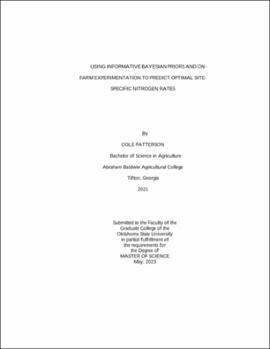| dc.contributor.advisor | Brorsen, B. Wade | |
| dc.contributor.author | Patterson, George Coleman | |
| dc.date.accessioned | 2023-08-25T20:06:24Z | |
| dc.date.available | 2023-08-25T20:06:24Z | |
| dc.date.issued | 2023-05 | |
| dc.identifier.uri | https://hdl.handle.net/11244/338951 | |
| dc.description.abstract | Precise site-specific nitrogen applications will reduce excess nitrogen fertilizer run-off and have corresponding environmental benefits. Adoption of site-specific nitrogen application technology has been slow, and many studies have shown that site-specific nitrogen fertilizer is not yet unambiguously profitable. Most U.S. Corn Belt states now recommend the Maximum Return to Nitrogen (MRTN) method for determining optimal nitrogen rates, which is based on 15 years of on-farm yield response to nitrogen trials. The MRTN method provides a uniform rate recommendation for a region of a state. This study goes beyond the MRTN method by combining the MRTN data, Bayesian methods, and on-farm experimentation to provide site-specific nitrogen recommendations. | |
| dc.description.abstract | On-farm trials are now being used to provide the information necessary for site-specific management. The issue is that recommendations from only a few years of data can be very noisy. Bayesian methods can combine the prior information from MRTN with data from on-farm experiments to provide more accurate site-specific nitrogen rate recommendations. The problem is that the needed models to use as Bayesian priors have not been estimated. This research fills this gap. Utilizing data from the Maximum Return to Nitrogen database, Bayesian estimation is used to estimate production functions that have a time trend to account for increased corn yields over time. The estimated models are then used as an informative prior for yield response estimations using on-farm experimental data. Three years of on-farm experimental data from a single field is used to estimate a spatially varying coefficient model. The model is estimated using two years of data to predict the third year. The predicted spatial variability was small and uncorrelated with spatial variability in the third year. Even though experimentation did not help with variable rate recommendations, it can provide uniform rate recommendations for a specific field. | |
| dc.format | application/pdf | |
| dc.language | en_US | |
| dc.rights | Copyright is held by the author who has granted the Oklahoma State University Library the non-exclusive right to share this material in its institutional repository. Contact Digital Library Services at lib-dls@okstate.edu or 405-744-9161 for the permission policy on the use, reproduction or distribution of this material. | |
| dc.title | Using informative Bayesian priors and on-farm experimentation to predict optimal site-specific nitrogen rates | |
| dc.contributor.committeeMember | Lambert, Dayton M. | |
| dc.contributor.committeeMember | Arnall, Brian | |
| osu.filename | Patterson_okstate_0664M_18102.pdf | |
| osu.accesstype | Open Access | |
| dc.type.genre | Thesis | |
| dc.type.material | Text | |
| dc.subject.keywords | Bayesian | |
| dc.subject.keywords | corn | |
| dc.subject.keywords | nitrogen | |
| dc.subject.keywords | on-farm | |
| dc.subject.keywords | precision | |
| thesis.degree.discipline | Agricultural Economics | |
| thesis.degree.grantor | Oklahoma State University | |
